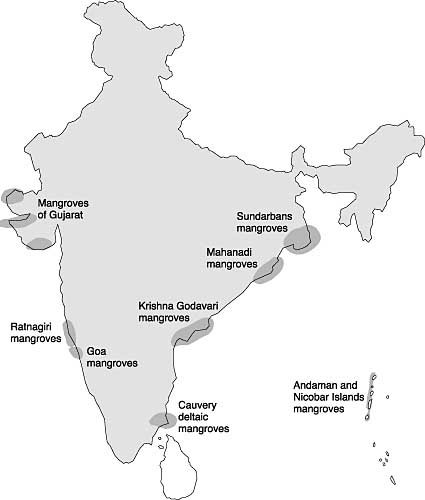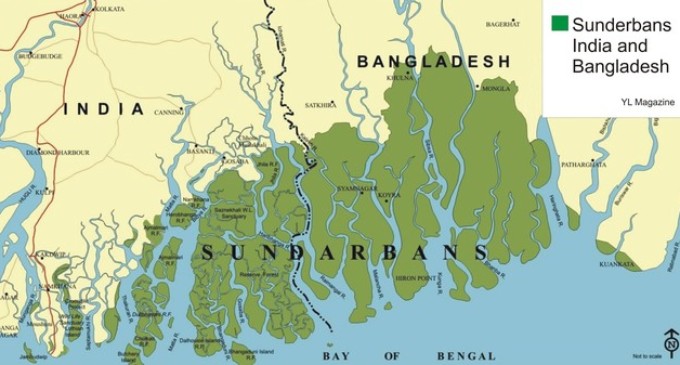Mangrove Ecosystem in India- Importance, Threats and Way Forward

Cyclone Amphan caused large scale damages to the state of West Bengal. One of the major loss incurred by the state was the damages to the Sundarban forests. The damage to Sundarbans is not merely an ecological and economic loss. These forests play a key role in protecting the region from the impacts of frequent cyclones. Also, a PIL has challenged the diversion of reserve mangrove forests in Maharashtra for construction activities. In this light, the importance of mangroves in India is to be examined.
This topic of “Mangrove Ecosystem in India- Importance, Threats and Way Forward” is important from the perspective of the UPSC IAS Examination, which falls under General Studies Portion.
What are mangroves?
- Mangroves or ‘tidal forests’ are a type of tropical wetland rainforest ecosystem noted for their salt-tolerant vegetation (halophytes). It can be thought of as an interface between terrestrial forests and marine ecosystem.
- Mangrove forests occupy 2,00,000 square kilometres of area across 30 tropical countries.
- They are found in tropical and sub-tropical tidal areas like marine coastlines and estuaries.
- These forests consist of vegetation that are small, shrubby and highly specialized to thrive in hostile conditions.
- It consists of diverse habitats like forests, mudflats, estuaries, rivers, coral reefs, etc.
- There are over 100 species of mangrove plants. These are home to around 174 species of marine mega fauna. Species like oysters, shrimps, sponges, barnacles, etc. are found here.
- These plants are capable of surviving in saline conditions with tidal water flows and muddy soil that is deficient in oxygen.
- They have upwards growing roots that enables them to absorb oxygen (something that is scarce in the glutinous muds). These are called pneumatophores.
- They have a specialised salt filtration system that can filter out the excess salt from the waters.
Where are mangrove ecosystem in India?
- India has about 4,921 square kilometres of mangrove forests. This is over 3% of the world total.
- The largest mangrove forest in India is the Sundarbans (meaning ‘beautiful forest’) in the Gangetic Delta. This mangrove stretches across India and Bangladesh.
- The 2nd largest mangrove ecosystem in India is the Bhitarkanika located on the Odisha coast.
- The Godavari- Krishna mangrove forests are located on the east coast of Andhra Pradesh.
- The Pichavaram mangroves are in Tamil Nadu.
- Mangrove forests are also found near Mumbai city on the western coast.
- They are also found on the Andaman and Nicobar islands. Eg: the Baratang Island mangroves.
Why are they important?
- Mangroves are structurally complex with diversified habitat. This means that they create unique environments that serve as niches for a large variety of organisms.
- These forests serve as breeding and feeding grounds and also as nurseries for a variety of commercially important marine organisms like fishes and crustaceans.
- NASA has termed them ‘the best carbon scrubbers’ because of their role as a significant carbon sink. They store more carbon dioxide than most of the other forest types.
- They filter out heavy metals from the mud and deposit them as rich sediments.
- The extensive mangrove root system is capable of weakening the impact of the sea on the land.
- The mangroves on the eastern coast helped mitigate the impact of the 2004 Boxing Day tsunami. These stretches were said to have behaved like car’s bumper (impact absorber) and crumple zones– absorbing massive amounts of energy from the waves.
- The Sundarbans serve as a flood barrier in West Bengal. They protect the city of Kolkata from the frequent cyclones– the most recent of which was the Cyclone Amphan.
- They have important ecological functions like recycling nutrients, etc.
- Sundarbans is a biosphere reserve and has been declared a ‘World Heritage Site’ by UNESCO. The Sundarbans is the largest delta declared as a UNESCO heritage site.
- It houses the largest number of Royal Bengal tigers in the world. It also houses over 250 species of birds, 120 species of fishes, reptiles like the salt water crocodiles, etc.
- Bhitarkanika is an important Ramsar Wetland site. More than 220 species of birds have been recorded from this area.
- It is also the largest known nesting site for the Olive Ridley sea turtles.
What happened to the Sundarbans during the Cyclone Amphan?
- When Cyclone Amphan struck West Bengal in May, its effects were largely mitigated by the Sundarbans flanking its coasts along the Bay of Bengal.
- However, the cyclone damaged over 28% of the Sundarbans. About 1,200 square kilometres of these forests suffered damages.
- The mangrove trees’ leaves turned yellow and red– especially in the Avicennia species. This phenomenon was more prominent among the non-mangrove trees further inland. This has been attributed to root damage and high salinity. Mangroves require a mix of freshwater and saline water to grow. Very high salinity can damage even these trees.
- The loss to mangrove wildlife proved difficult to determine. They tend to suffer the most during such cyclones.
- The impact of the damage was also felt by the communities that depend on these mangroves. Also, the saline water ingress affected agricultural activity in the adjoining area.
- In the aftermath of the disaster, the West Bengal government announced plans to plant 50 million mangrove trees to compensate for the loss due to the cyclone.
- However, this plan is being criticised as it doesn’t take the space availability into consideration. Experts say that a single hectare can hold 5,000 mangrove trees at the most. In that case, the proposed 50 million trees would require a 100 square kilometre area.
- This is difficult given that many similar mangrove replantation projects have been stalled due to space scarcity.
- However, the government is in the process of identifying lands for this project and plantations is to start next October.
What are the threats to the mangroves?
- Anthropogenic activities are a major threat to the mangroves. Urbanisation, industrialisation and the accompanying discharge of industrial effluents, domestic sewage and pesticide residues from agricultural lands threaten these fragile ecosystems.
- Saltpan and aquaculture causes damage to the mangroves. Shrimp farming alone destroyed 35,000 hectares of mangroves.
- Fragmentation of mangrove forests is another consequence of unplanned human expansions. Fragmentation affects the dispersal and movement of species.
- Some species like Bruguiera cylindrica and Sonneratia acida are at the brink of extinction.
- 40% of mangroves on the west coast has been converted into farmlands and other settlements in just 3 decades.
- The mangroves on the Maharashtra coast stretched over 200 km in the 1970s. By 2001, the stretch reduced to 118 km.
- The mangroves in Maharashtra are facing further destruction as the upcoming bullet train project requires the cutting down of 13.36 ha of mangroves in the Thane creek. Nearly 30,000 trees are to be cut down for the project.
- Rising sea levels is another challenge to these mangroves- especially on the Bay of Bengal coast.
- Climate change is increasing the frequency of extreme weather events like the Amphan cyclone. The mangroves are one of the most vulnerable ecosystems to these natural calamities.
What are the efforts taken to protect these mangroves?
- The Sundarbans is the first mangrove forest in the world to be put under scientific management. The plan was implemented as early as in 1892.
- In 1976, the National Mangrove Committee was set up under the Environment Ministry.
- In 1979 it recommended focus on areas like mapping of mangroves using remote sensing, land surveys, etc., to determine degradation rate, assessing sites for establishing reserve forests, conservation program, afforestation, R&D etc.
- Several legislations like Environment (Protection) Act, Indian Forest Act, Wildlife Protection Act, Forest Conservation Act, etc. are sources of protection (though mangroves are not specifically mentioned in all of these).
- In 2013 the Biotechnology Department started a bio-restoration program in pilot mode in the Sundarbans. It involves stabilisation of degraded mangrove stretches with native grasses (salt-tolerant varieties). An on-site nursery is also set up. These nurseries grow a variety of mangrove species- native, associated, threatened, endangered, etc. 22 species were raised in these nurseries to maintain diversity. Transplantation was done in 2014.
- The Maharashtra government had announced that 5 times the number of trees cut down for the bullet train project are to be planted as part of restoration efforts.
- In 2005, the Mumbai High Court had classified mangroves as forests. In 2018, the High Court called the destruction of mangroves an offence to the fundamental rights of the citizens under article 21 of the Constitution.
- Since then, the government has been undertaking efforts to conserve the mangroves. In 2016, the Maharashtra government declared over 15,000 hectares of mangroves as reserve forest. Construction within 50 m of these mangroves is illegal.
- In 2018, India along with 7 other countries of the Bay of Bengal region came together to protect the mangroves under the BOBLME (Bay of Bengal Large Marine Ecosystem) project. The UN Food and Agriculture Organisation leads this project. The GEF (Global Environment Facility) approved a grant of 15 million USD for this project.
- According to the 2019 State of Indian Forest Cover Report, the mangrove forest cover in Maharashtra has increased by 72% in the last 6 years. This is an increase of 134 square kilometres.
What is the way forward?
- Systematic and periodic environmental monitoring of existing mangroves. The various faunal species dependent on these forests must also be documented.
- Use of bio-restoration to revive degraded stretches of mangroves. These techniques help maintain the original biodiversity. Ecological restoration revives the mangroves at a faster rate than natural regeneration.
- Instead of monoculture plantation of mangrove species, restoration efforts should involve sufficient species diversity. This will raise forests that are more resilient to the impacts of climate change.
- A major need is the enforcement of legislative mandate.
- Private sector establishments near the mangroves can be incentivised to take up conservation activities.
- Community participation for conservation and management. The communities dependent on these forests can be supported to take up alternative economic activities to increase sustainable use of these mangroves. At the same time, community level conservation of the mangroves should be incentivized.
- Cultural advantages can be leveraged in mangrove conservation. Eg: Bon Bibi is a forest goddess worshipped by people of different faiths (Hindus & Muslims) in the Sundarbans. The Bon Bibi faith checks excessive acquisition and greed in Sundarbans- people are to enter the forests only when absolutely necessary (eg: livelihood), people are not to carry weapons into the forests, smoking in the forest is seen as a desecration, etc.
Conclusion
A range of forest types across the world are facing threats from anthropogenic activities. The damages to the Sundarban forests is only the latest example of climate change driven destruction of forests and other ecosystems across the world- like the recent Amazon forest fires and the Australian bushfires. Such events are only to increase in frequency in the future. It is high time to conserve what remains and to restore what was lost.
Practice question for mains
Discuss the importance of mangrove forests in view of the increasing incidence of extreme weather events. What can be done to conserve them from these events? (250 words)







Crisp and Clear.. and looking Forward..
thanks a lott to the admin . your blog helped me for my college project a lott . Keep growing God bless